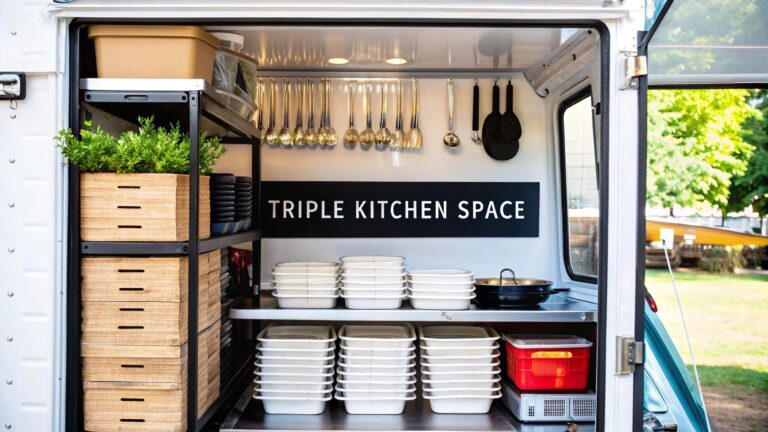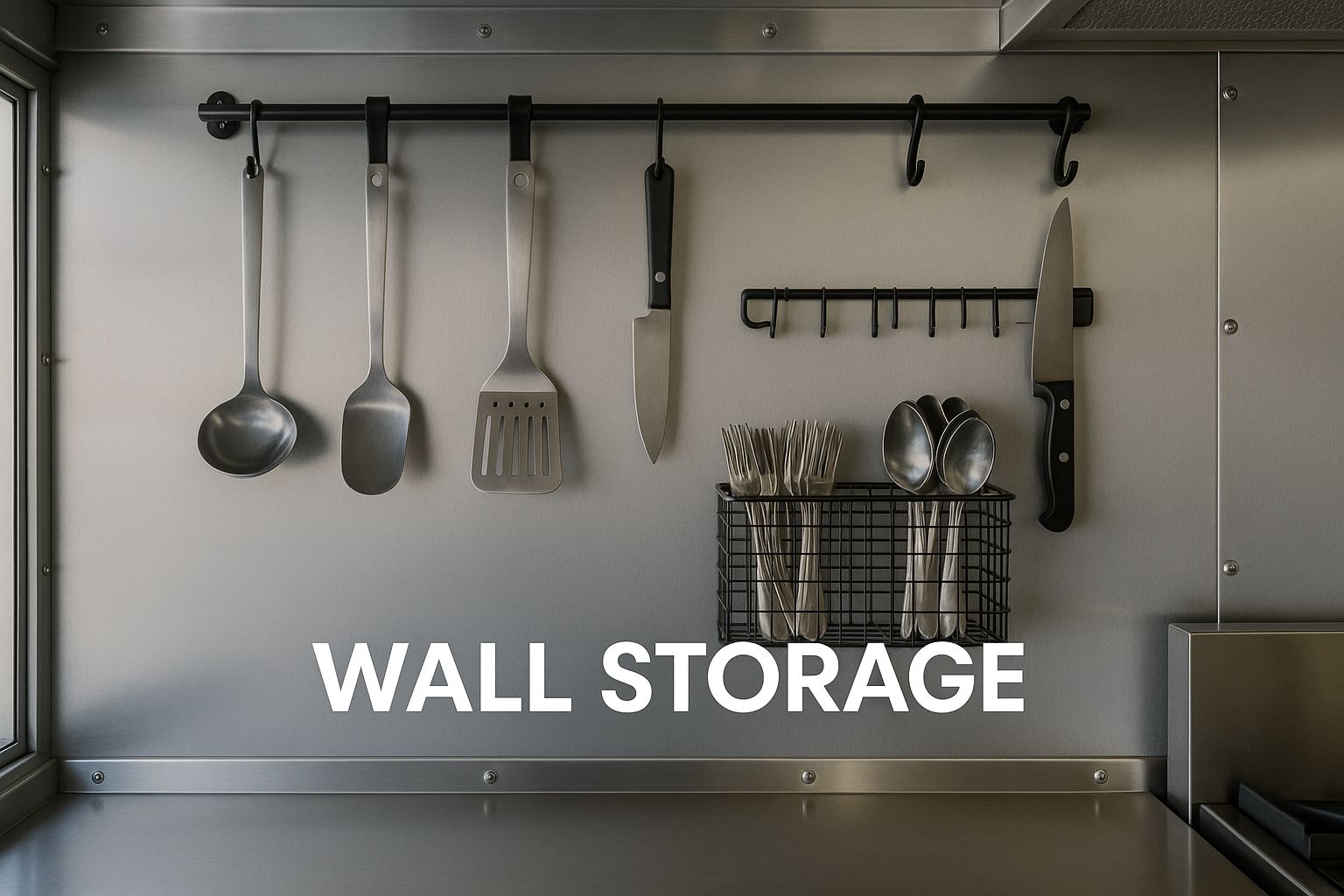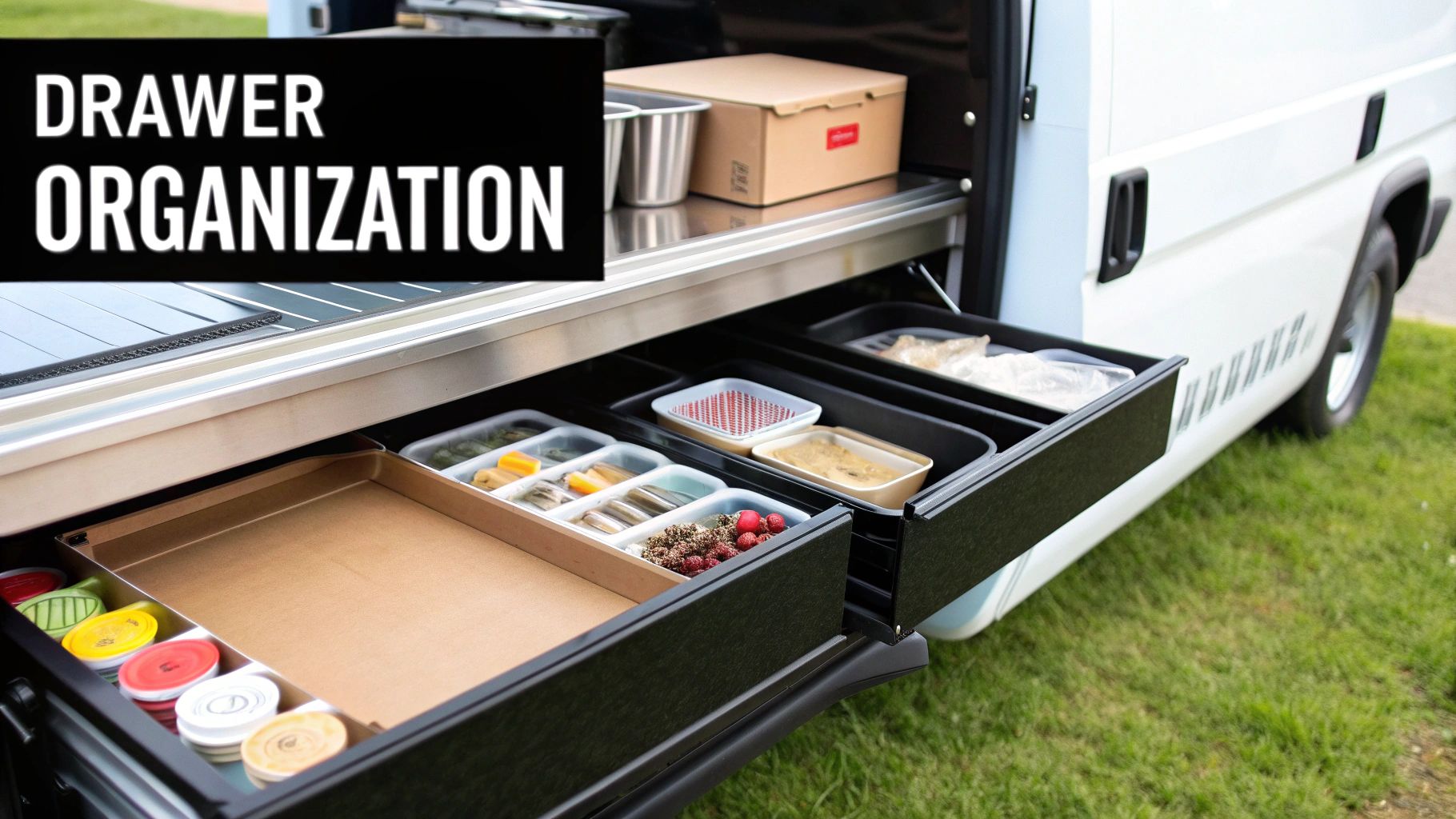The Storage Crisis That’s Killing Food Truck Profits
Implementing your food truck storage ideas hinges on making the most of limited space, especially in the kitchen. Cramped quarters can quickly become disorganized, directly impacting your profits. Imagine your staff struggling to find ingredients during the lunch rush. This slows down service, frustrates customers, and ultimately, hits your bottom line.
Industry surveys reveal that roughly 60% of food truck owners cite efficient storage as a major challenge. Clearly, tackling this issue is vital for any food truck aiming to succeed.
Recognizing the Warning Signs of Storage Problems
Knowing the early signs of storage issues is key. These can include difficulty finding ingredients, inconsistent prep times, and frustrated staff.
Wasted space, expired ingredients from poor stock rotation, and difficulty maintaining kitchen cleanliness can also indicate underlying storage problems. This highlights that proactive food truck storage ideas and solutions are a necessity, not a luxury.
Why Traditional Storage Fails in Food Trucks
Standard restaurant storage simply doesn’t work in a food truck’s limited space. Static shelving designed for larger kitchens often becomes cumbersome in a mobile setting.
Food trucks demand storage that is both accessible and secure while on the move. This calls for a new approach to space management, one that balances practicality and mobility.
Turning Storage Limitations into Advantages
The best food truck storage ideas and operators see storage limitations not as obstacles, but as chances to innovate. They prioritize versatility and adaptability.
For example, they might use wall-mounted systems secure during travel yet easily accessible during service. They also invest in stackable containers and custom shelving tailored to their menu and workflow. This smart strategy turns a potential weakness into a strength, boosting efficiency and, ultimately, profits.
Smart Investment Strategies For Storage Upgrades
This infographic demonstrates how to get the most out of limited wall space. Using simple hooks and wire baskets, a food truck can keep utensils organized and within easy reach. This practical wall storage solution frees up valuable counter space, which is essential for a smooth workflow in any compact kitchen.
Equipping a food truck is a significant investment, typically ranging from $50,000 to $200,000 in developed markets. Toast POS provides a helpful breakdown of these costs. Food truck storage ideas and solutions can account for up to 20% of this initial investment, highlighting the importance of strategic planning for your storage upgrades. Smart decisions in this area can have a significant impact on your ROI (Return on Investment).
Budget-Friendly DIY Upgrades
Small, cost-effective changes can make a big difference. DIY modifications under $500, such as installing magnetic knife strips, adding shelves, and using stackable containers, can significantly improve kitchen organization. These affordable upgrades often offer a quick return by streamlining workflow and minimizing wasted time searching for misplaced items.
Professional Installations for Maximum Impact
For a more comprehensive overhaul, consider professional storage installations. Custom-built shelving units, slide-out drawers, and equipment-specific storage solutions maximize space utilization. While the upfront cost is higher, the long-term benefits of increased efficiency and storage capacity can substantially boost profits.
To help visualize the potential impact of different food truck storage ideas, let’s examine a comparison of investment costs versus operational benefits:
Storage Investment vs. Operational Impact Comparison
| Storage Solution | Investment Range | Efficiency Gain | Payback Period |
|---|---|---|---|
| DIY Modifications (Shelves, magnetic strips) | $100 – $500 | 10-20% (estimated time savings) | 1-3 Months |
| Modular Shelving Units | $500 – $2,000 | 20-35% (estimated time savings) | 6-12 Months |
| Custom-Built Storage (including specialized equipment storage) | $2,000+ | 35-50% (estimated time savings) | 12-24 Months |
This table illustrates how even smaller investments can offer considerable efficiency gains, leading to faster payback periods. Larger investments, while requiring more upfront capital, can result in even greater long-term efficiency and profitability.
Prioritizing Storage Investments for ROI
Successful food truck operators prioritize storage upgrades that directly impact operational efficiency and profitability. Investing in solutions that streamline food preparation or reduce service time typically yields a higher return than purely aesthetic improvements. This strategic approach to storage investment transforms a cramped kitchen into a well-oiled, profit-generating machine.
Vertical Storage Systems That Transform Small Spaces
In the bustling world of food trucks, efficient storage is paramount. Smart organization isn’t just about tidiness; it’s about making the most of every inch of precious space. This means rethinking your approach and embracing vertical storage solutions.
Savvy food truck owners recognize the importance of maximizing vertical space. This strategy significantly increases storage capacity, keeping valuable floor space free for crucial food prep and easy movement within the truck.
Wall-Mounted Wonders: Making The Most of Vertical Surfaces
Wall-mounted systems are a true game-changer in the food truck world. These can range from simple magnetic strips holding knives and utensils to more substantial shelving units built to endure the daily rigors of the road.
Heavy-duty racks, for example, can securely store frequently used ingredients. Specialized holders keep spices organized and within easy reach. Also, consider installing foldable shelves or tables that can be stowed away while driving and then deployed during service.
Reaching New Heights With Ceiling Storage
Looking up reveals another untapped storage opportunity. Ceiling-mounted storage is perfect for less frequently used items like extra napkins, paper goods, or cleaning supplies.
Safety, however, is the top priority. Ensure all overhead storage is firmly secured to prevent accidents during travel. This may involve specialized brackets or netting to keep items contained.
Stackable Solutions: The Building Blocks of Efficient Storage
Stackable containers, bins, and crates are essential tools for maximizing space and keeping everything in order. They are versatile enough for storing anything from prepped ingredients to dry goods.
Food trucks utilizing custom modular storage have reported a 25% increase in stock capacity. This added capacity has a direct impact on sales and customer satisfaction.
Organizing For Efficiency and Safety
The key to effective vertical storage lies in organizing by frequency of use. Keep frequently used items at readily accessible levels, reserving higher or lower spaces for less frequently needed items.
This thoughtful arrangement minimizes unnecessary reaching and bending, promoting a smoother, more efficient workflow. Consider color-coding your storage containers for even better organization and faster ingredient retrieval.
Technology Solutions That Actually Pay For Themselves
Technology is constantly changing the food truck industry, especially when it comes to storage. But which tech upgrades are worth the investment? This section explores practical solutions that streamline operations and improve your food truck storage, boosting your bottom line and avoiding expensive distractions.
Streamlining Inventory With Tech
One of the smartest investments for food trucks is inventory tracking software. These apps help manage stock, predict demand, and minimize food waste – essential in a limited space where overstocking quickly leads to spoilage and chaos. These apps also generate reports on your best sellers, informing purchasing decisions and further reducing waste. Some even integrate with your POS system, automatically updating inventory as you make sales.
Food trucks worldwide are increasingly using tech-driven storage. Since 2020, the adoption of solutions like smart fridges with inventory trackers and stackable bins has grown at a rate of 15% year over year.
Smart Refrigeration: Optimizing Space and Energy
Smart refrigeration systems go beyond simple temperature control. They optimize space and reduce energy consumption, sometimes with built-in inventory management features that further streamline operations. Lower energy bills and less food spoilage mean this technology can quickly pay for itself.
Automated Storage Solutions
Imagine a system that automatically rotates your stock, ensuring older ingredients are used first. Automated storage solutions, while a significant investment, can dramatically reduce waste and labor costs over time. This is particularly beneficial for high-volume food trucks or those with complex menus.
Digital Inventory Management: Preventing Overstocking
Ditch the spreadsheets! Digital inventory systems are a game-changer, offering real-time visibility into stock levels. This enables informed purchasing decisions, preventing overstocking, freeing up precious storage space, and minimizing spoilage. Some systems even predict demand based on sales history, optimizing inventory for peak efficiency.
Temperature Monitoring For Food Safety
Food safety is crucial for every food truck. Temperature monitoring systems alert you to any fluctuations that might compromise food quality. These range from simple thermometers with alarms to sophisticated sensors integrated with refrigeration units. Protecting your customers also protects your reputation and profits.
Recommended Storage Apps
Successful food truck operators often rely on specific storage apps tailored to mobile kitchens. Popular choices include apps for tracking inventory, managing orders, and even optimizing routes. Researching the right app for your needs can greatly enhance your efficiency and profitability.
Adaptable Storage For Menu Evolution And Growth
The most successful food trucks are constantly evolving. They adapt to customer preferences, seasonal ingredients, and the latest food trends. This requires a dynamic storage system—one that can be easily reconfigured as the menu changes and the business grows. Think of it as a transformer, shifting and changing to meet different demands.
This adaptability is essential for long-term success in the competitive food truck industry. Being able to quickly adjust storage configurations allows owners to maximize space and efficiency.
Modular Magic: The Key To Flexibility
Modular storage solutions are the foundation of an adaptable food truck kitchen. These systems allow operators to easily reconfigure their workspace. Removable shelves, for example, can be adjusted to hold different inventory sizes, while adjustable compartments can be resized based on the current menu.
This kind of flexibility minimizes wasted space and maximizes efficiency, both of which are crucial in a compact food truck environment. Being able to customize the storage layout ensures that every inch of space is used effectively.
Multi-Purpose Units: Growing With Your Business
As your food truck business grows, your storage solutions should grow with it. Investing in multi-purpose storage units provides the adaptability needed for expansion. These units can serve various functions as your needs change.
For instance, a unit initially used for dry storage could later house specialized equipment for a new menu item. This adaptability reduces the need for costly renovations or equipment replacements, making it a smart investment for the future.
Pivoting To Opportunity: The Adaptability Advantage
Adaptable storage gives food trucks a significant competitive edge. This flexibility allows operators to quickly capitalize on new opportunities, such as catering events or introducing seasonal menus.
This advantage was evident during the COVID-19 pandemic. Food truck operators with flexible storage systems were 50% faster to pivot to new menu offerings. This demonstrates the value of adaptable storage.
Designing For Evolution: From Startup To Expansion
Planning for adaptability is crucial from the initial startup phase through periods of expansion. Consider how your menu might evolve in the future. What special events might you cater?
Thinking ahead and incorporating flexible storage solutions from the outset will save you time and money down the line. This proactive approach allows you to test new menu items or catering options without major equipment investments, ultimately fostering innovation and growth.
Organization Systems That Accelerate Service Speed
Effective food truck storage ideas isn’t just about cramming as much as you can into your limited space; it’s about being able to find what you need quickly, especially when you’re slammed with customers. Frantically searching for ingredients slows down service and eats into your profits. This section explores some simple organizational strategies that can minimize search time and boost your team’s efficiency.
Color-Coding: A Visual Shortcut
Imagine your storage bins as a vibrant rainbow: red for sauces, green for veggies, and blue for meats. Color-coding allows your staff to quickly locate ingredients, eliminating precious seconds wasted rummaging. This straightforward system is especially beneficial for new employees, enabling them to get up to speed quickly and contribute effectively during busy periods.
Strategic Placement: Putting the Essentials at Your Fingertips
Think of your food truck kitchen like a Formula 1 pit stop: every second counts. Position frequently used items—like burger patties, buns, or popular toppings—in the most accessible locations. This strategic placement minimizes unnecessary movement and maximizes speed during those critical service windows.
Prep Organization: The Foundation of a Smooth Service
Proper prep organization is like having an extra set of hands in the kitchen. Pre-portioning ingredients into clearly labeled containers and storing them logically streamlines the entire cooking process. This translates to less time spent measuring and chopping during the rush, and more time dedicated to serving your hungry customers. Accurate labeling is especially important for food trucks, helping with inventory, tracking freshness, and meeting regulations. All these contribute to a more efficient operation.
Maintaining Order in the Chaos
Even the best-laid plans can go awry during a busy lunch rush. Implementing clear procedures for restocking and returning items to their designated spots is essential. This prevents a mid-service scramble and helps maintain the efficiency gains you’ve achieved through your organizational efforts.
Empowering New Staff With a System
A well-organized system benefits everyone, but it’s especially helpful for new hires. Standardized locations and clear visual cues shorten the learning curve, allowing new team members to become productive quickly. This reduces training time and ensures consistent service quality, even with staff changes.
Optimizing With Visual Cues and Logical Groupings
Visual cues—like clearly labeled shelves and color-coded bins—combined with logical groupings of ingredients (by type or usage frequency) create a highly efficient storage system. This is particularly important in the compact space of a food truck, where every inch is valuable real estate. Regularly assess and adjust your system based on your menu and workflow to maintain peak performance.
To help you get started, here’s a checklist you can use:
Service Speed Optimization Checklist
| Organization Practice | Setup Time | Speed Impact | Difficulty Level |
|---|---|---|---|
| Strategic Placement of Frequently Used Items | Low | High | Easy |
| Color-Coding Ingredients | Medium | High | Easy |
| Pre-portioning Ingredients | Medium | High | Medium |
| Implementing Restocking Procedures | Low | Medium | Easy |
| Labeling Shelves and Bins | Low | Medium | Easy |
| Regularly Assessing and Refining System | Low | High | Medium |
This checklist provides a framework for optimizing your food truck’s organization. By focusing on the practices with high-speed impact and low difficulty, you can quickly improve your service speed and efficiency. Remember that even small changes can make a big difference in a fast-paced food truck environment.
Your Action Plan For Storage Transformation
Ready to optimize your food truck’s storage and boost your profits? This action plan provides a step-by-step guide for prioritizing improvements, planning installations, and measuring your success. We’ll explore timelines for upgrades, vendor selection, realistic expectations, and ongoing maintenance.
Prioritizing Your Storage Upgrades
Start by assessing your current storage situation. Where are the biggest bottlenecks? Which areas cause the most frustration for your staff? Prioritize upgrades that address these pain points first.
For example, if finding ingredients during the lunch rush is a constant struggle, focus on food truck storage ideas and solutions that improve accessibility to frequently used items. If spoilage is a problem, prioritize refrigeration upgrades or inventory management technology.
Planning and Implementing Your Storage Solutions
Once you’ve identified your priorities, develop a detailed plan. This should include:
- Step-by-step timelines: Break down each upgrade into smaller, manageable tasks with realistic deadlines.
- Vendor selection criteria: Choose vendors specializing in mobile kitchen equipment who understand the unique demands of a food truck environment.
- Realistic expectations: Understand that not all upgrades will deliver immediate results. Some solutions require a learning curve or adjustments to your workflow.
Phasing Implementations for Minimal Disruption
To avoid disrupting your daily operations, implement your food truck storage ideas and upgrades in phases. This allows you to adjust to each change and minimize downtime.
For instance, begin with smaller DIY projects like adding shelves or magnetic strips. Then, gradually introduce more complex installations like custom shelving or refrigeration upgrades. This phased approach minimizes disruption and allows for continuous improvement.
Maintaining and Optimizing Your Storage System
Effective storage requires ongoing maintenance and optimization. Develop a regular cleaning and organization schedule. Track your inventory meticulously to identify areas for improvement. Solicit feedback from your staff to identify pain points and refine your storage system over time.
This ongoing evaluation is crucial. As your business grows and your menu evolves, your storage needs will also change. Continuously refining your system ensures that your storage remains efficient and aligned with your business goals. Regular maintenance also prevents small problems from escalating into larger, more costly issues. Additionally, consider how factors like seasonal menus or special events may impact your storage needs.
For all your disposable food packaging needs and to optimize your storage with the right supplies, visit MrTakeOutBags.com. They offer a wide variety of solutions tailored to the food service industry.






Comments are closed.